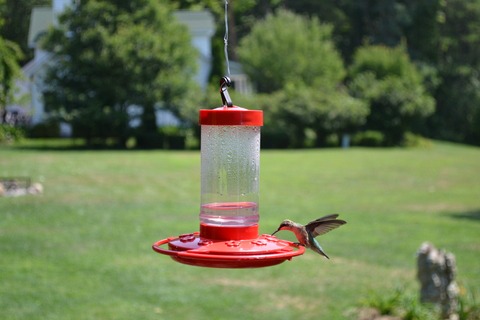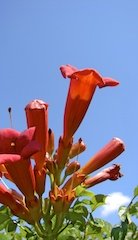Hummingbird Feeders
Hummingbird feeders are available in a mind-boggling array of styles and colors. They’re mainly made from glass, ceramic, and plastic.

They come in two primary forms but can be crafted to resemble anything from a tiny house to a whimsical abstraction.
The bottle form is typically narrow and upended.
This tubular shape lends itself to a number of different designs and styles. This makes it the more popular of the two. Know that it can be difficult to fill and clean.
Basin form feeders are simpler than bottle form feeders. They’re shaped like a shallow basin or saucer exactly as the name implies. They come apart easily.
Cleaning and refilling these feeders is a relatively painless job compared to the bottle form feeders.
In terms of material there’s no significant functional difference between glass, ceramic, and plastic feeders.
Of course, glass and ceramic feeders are more fragile than plastic ones.
Consider that plastic of any sort degrades over time, releasing BPA chemicals. This can be potentially harmful to your hummers, although no studies have been done investigating the effects of BPA on hummingbirds.
Feeder Filling Mechanism
Hummingbird feeders are also distinguished by the filling mechanism.
Top fill feeders open up at the top and the syrup is poured down into the bowl of the feeder. These feeders are easy to fill but more difficult to take apart and clean.
Conversely, bottom fill feeders open at the bottom and need to be removed and hung again each time they’re filled. This slight disadvantage is far outweighed by the fact that bottom fill feeders are easier to dismantle and clean.
When To Put Up Your Feeder
Once you have chosen a feeder you like hang it up in a shaded, protected place in your garden or deck. Make sure it’s hung high enough to keep visiting birds safe from other animals.
Your feeder should be put up in time to attract the first arrivals from Central and South America. This is going to change according to where you live.
If you live in Texas you’ll begin seeing Ruby-throats arriving in March. On the other hand, the Rufous will migrate through California during February to May and end up in British Columbia by early April. By mid-April, they’ll be in Alaska.
In Florida, some will arrive in early January. Live farther north, say in the Great Lakes area? You’ll want to be ready for those first hummingbirds that arrive in May.
So, based on your area be sure you’re ready! Get your feeders up about five to ten days prior to the arrival of our favorite tiny birds.
How Many Hummingbird Feeders?
It’s important to have more than one. Hummingbirds are territorial.
Once the males arrive and begin staking their claim to your garden, you want to be sure you don’t end up with only one staying for an extended period. Set up you feeders in such a way that the first male can’t easily see the 2nd, 3rd, or 4th. This way, you can attract a greater variety of hummingbird groups to your garden.
While most feeders come in the color red you can also attach a red streamer or two. This will help ensure it’s more easily spotted.
Place your feeders near “cover” areas. Once your hummingbirds are done feeding they’ll want to retreat to areas of cover to rest. Placing feeders near vines, shrubs, trees, or flowers is ideal. Once you’ve fostered hummingbird activity you can move the feeders to more shaded areas.
Keeping them shaded will help ensure the nectar doesn’t become moldy in hot weather.
Filling Your Feeders
Use a sugar solution of one part sugar to four parts water.
Don’t use honey. It can become toxic to your birds. It ferments quickly and the resulting bacteria can be harmful.
It’s best to use tap water as opposed to distilled water. Mix the sugar in warm water. If you’d like to boil it first to help slow mold growth be sure you let it cool before placing it out for your hummers.
Only fill your hummingbird feeders to the point where they’ll be emptied within a few days (about 2-3 days). This way you’ll allow for a lesser chance of mold before you do your next fill-up.
Clean Often
It’s important to follow a regular maintenance routine. A dirty feeder filled with fermented sugar water or covered in black mold is toxic.
As I mentioned above the sugar syrup must be emptied every few days (especially when it’s a hot summer) and the feeder needs to be rinsed with hot water.
At least once a month clean your feeders with a bleach or vinegar solution. Use a ratio of 1 part vinegar or bleach and 10 parts water. Rinse extremely well.
What About Ants?
Ants love that sugar water too! Since ants can’t swim they’ll end up decomposed in your solution. This ruins the mixture for the hummingbirds.
The fact that ants can’t swim plays into the solution.
A simple solution is to buy an ant moat. All you do is insert the moat between your feeder and its hanger. The ants can’t get past the moat in order to reach the feeder.
When Should You Take Your Feeder Down?
Some folks believe that taking down a feeder will prevent hummingbirds from properly migrating. This isn’t true. Often, male hummingbirds will begin leaving even before the natural insect and flower food sources wane.
The true “activator” is nature’s evolution toward winter as shorter days signal the time to begin migration.
A good rule of thumb is to remove your feeders about 2 weeks after you see your last hummingbird.
Regardless of the style or shape you choose, hummingbird feeders and the birds that flock to them are a delightful addition to any outdoor space.
Subscribe to my updates!
Hummingbirds > Hummingbird Feeders






